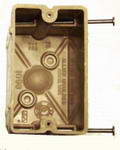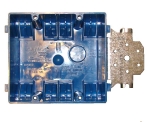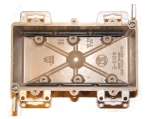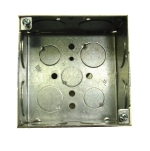More about Electrical Junction Boxes |
Recent Questions and CommentsSee more at the Electrical Questions Category Listing. |
» Residential Home Wiring Diagrams
» Need Electrical Help? Ask the Electrician
Electrical Wiring Junction Boxes

|
By Dave Rongey
Summary: Types of Electrical Wiring Boxes for Residential Wiring Projects. Understanding electrical junction boxes and what they are used for. Home electrical wiring is the process of installing electrical wire to a location that will serve electrical devices or an appliance. © By: Dave Rongey |
Electrical Junction Boxes, Fixture Boxes, Receptacle Boxes, Splice Boxes
One very important component is the box where the wire will be installed. The type and size of the home wiring electrical boxes will depend upon the circuit size, application and its location.
Box Fill - How many wires you can put in a box? The NEC Code requires wiring to be protected and enclosed when devices such as receptacles, fixtures and switches are being installed. Sometimes it is necessary to junction or splice wires in home wiring electrical boxes.
When splicing wires, an accessible electrical junction box box is necessary to enclose the spliced wires, thus the trade name is electrical enclosure.
This list shows various electrical boxes and displays the box name and describes the typical application.
The most common type of materials that home wiring electrical boxes are made of are: plastic, fiberglass, steel, aluminum and bakealight. The metal boxes come with knock-outs for using conduit such as EMT (electrical metallic tubing) or flex- steel or aluminum.
Why don't you see the exact same electrical box at your supplier? The availability of the types of boxes will depend upon which electrical manufacturer or purchasing channel your supplier has a contract with.
Boxes and Wire-Fill
How many wires can be installed into an electrical box will depend on how many Cubic Inches the box has and what size wires are being installed.
Below is a chart of a few common home wiring electrical boxes and the actual information which should be stamped or molded into each enclosure.
A good rule of thumb is to never over fill a box, leave yourself plenty of room, and don't cut your wire too short either - you can always trim off a little, but you can't stretch it. Keep in mind that the Ground Wires are not counted.
| ELECTRICAL BOX EXAMPLES |
Box CU.IN.
|
#14 Wires
|
#12 Wires
|
#10 Wires
|
| 3-INCH PANCAKE METAL | 4.5 | 2 | 2 | 0 |
| 3-INCH CUT-IN FIBERGLASS | 14.0 | 7 | 6 | 5 |
| 1-GANG CUT-IN FIBERGLASS | 16.0 | 8 | 7 | 6 |
| 1-GANG CUT-IN FIBERGLASS | 18.0 | 9 | 8 | 7 |
| 1-GANG NAIL PLASTIC | 20.5 | 10 | 9 | 8 |
| 2-GANG CUT-IN FIBERGLASS | 28.0 | 14 | 12 | 11 |
| 2-GLASS FACE NAIL PLASTIC | 32.0 | 16 | 14 | 12 |
| 3-GANG CUT-IN FIBERGLASS | 42.5 | 21 | 18 | 17 |
| 2-GANG NAIL PLASTIC | 43.5 | 21 | 19 | 17 |
More about Electrical Box Fill CalculationsElectrical Code for Electrical Box Fill Capacity |
Common Home Electrical Wiring Boxes and How to Use Them |
| Electrical Box | Part Name | Electrical Applications |
|---|---|---|
 |
1-Gang Plastic Nail Box used for Type NM Cable wiring. Also known as a Rough-In Box. | Outlets and Switches. |
 |
1-Gang Fiberglass Cut-In Box with a Back Bracket. | Outlets and Switches. Type NM Cable wiring. Used with cable wiring in Remodel applications. |
 |
1-Gang Metal Cut-In Box with Adjusting Mounting Ears. | Outlets and Switches, with knock-outs for steel or aluminum flex. |
 |
1-Gang Handy Box. | Outlets and Switches. Surface mount Microwave Receptacle. Garage or Shop area with Conduit. |
 |
2-Gang Plastic Nail Box. |
Outlets and Switches. |
 |
2-Gang Fiberglass Cut-In Box. | Outlets and Switches. |
 |
2-Gang Plastic Face Nail Box. | Outlets and Switches. Great for tight areas with limited room to nail. |
| 3-Gang Plastic Side Nail Box. | Outlets and Switches. | |
| 3-Gang Face Nail Box. | Outlets and Switches. | |
 |
3-Gang Fiberglass Cut-In Box. | Outlets and Switches. |
 |
4-Gang Plastic Nail Box. | Switches and Lighting Controls. |
 |
3-Inch Fiberglass Nail Box. | Lighting Fixtures and Junctions. |
 |
3-Inch Fiberglass Cut-In or Remodel Box. | Lighting Fixtures and Smoke Detectors. |
 |
3-Inch Metal Pancake Box, also available in Fiberglass. | Lighting Fixtures. Mounted on the surface of the framing to be flush with finished sheet rock. |
 |
4-Inch Plastic Nail Box. | Lighting Fixtures |
 |
Spanner Box. | Lighting Fixtures |
 |
4-Inch Ceiling Fan Box. | Ceiling Fan Pancake Box, approved for 70 Lb Support. |
 |
4-Square Metal Box. Use with raised rings for 1 or 2 Gangs, 3-0 or 4-0 openings. | Receptacles and Switches. Surface mount for use in Garage or Shop area with EMT or Flex Conduit. |
The Safest Way to Test Electrical Devices and Identify Electric Wires!The Non-Contact Electrical TesterThis is a testing tool that I have had in my personal electrical tool pouch for years, and is the first test tool I grab to help identify electrical wiring. It is a Non-contact tester that I use to easily Detect Voltage in Cables, Cords, Circuit Breakers, Lighting Fixtures, Switches, Outlets and Wires. Simply insert the end of the tester into an outlet, lamp socket, or hold the end of the tester against the wire you wish to test. Very handy and easy to use.
The Quickest Way to Check for Faulty Electrical Wiring!The Plug-In Outlet TesterThis is the first tool I grab to troubleshoot a problem with outlet circuit wiring. This popular tester is also used by most inspectors to test for power and check the polarity of circuit wiring. It detects probable improper wiring conditions in standard 110-125 VAC outlets Provides 6 probable wiring conditions that are quick and easy to read for ultimate efficiency Lights indicate if wiring is correct and indicator light chart is included Tests standard 3-wire outlets UL Listed Light indicates if wiring is incorrect Very handy and easy to use.
Strip Off Wire Insulation without Nicking and Damaging the Electric Wire!The Wire Stripper and Wire CutterMy absolute favorite wire stripping tool that I have had in my personal electrical tool pouch for years, and this is the tool I use to safely strip electrical wires. This handy tool has multiple uses: The wire gauges are shown on the side of the tool so you know which slot to use for stripping insulation. The end of the tool can be used to grip and bend wire which is handy for attaching wire onto the screw terminals of switches and outlets.. The wire stripper will work on both solid and stranded wire. This tool is Very Handy and Easy to Use. |
||
Residential Electrical Parts and AccessoriesLight Switches 120volt Outlets Circuit Breakers Electrician Tools Voltage Testers |















